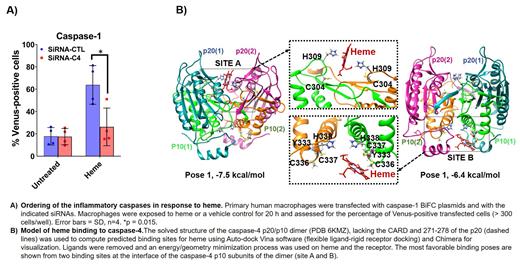Background: Sickle cell disease (SCD) is an inherited red blood cell disorder that impacts millions of people worldwide. Patients with SCD experience chronic hemolysis and have elevated serum levels of free heme. Free heme activates a variety of inflammatory pathways that contribute to the serious clinical complications of SCD. One of the inflammatory pathways activated by heme is the inflammatory caspase pathway. Our lab previously showed that heme exposure in macrophages leads to the activation of inflammatory caspase proteins caspase-1 and caspase-4. Activation of these proteins by heme leads to IL-1β release and pyroptosis, a form of inflammatory cell death. Patients with SCD have increased circulating IL-1β levels, indicating this pathway is active in patients. In mouse models, inflammatory caspases are required for hemolysis-induced neutrophil recruitment and lethality, indicating these proteins are central to hemolysis-induced inflammation. Despite the key role these proteins play following hemolysis, it remains unknown how heme activates inflammatory caspases. Interestingly, both caspase-1 and caspase-4 are required for heme-induced IL-1β release while caspase-4 alone is required for heme-induced pyroptosis. In fact, pyroptosis likely is required for IL-1β release from the cell. Based on this data, we hypothesized that caspase-4 is the apical step in this pathway and a key druggable target for controlling unchecked inflammation in SCD.
Results: We first sought to determine if caspase-4 activation is upstream of caspase-1 activation. To assess this, we used an imaging-based caspase activation reporter assay. Using this system, we found that siRNA knock-down of caspase-4 in primary human macrophages significantly inhibited heme-induced caspase-1 activation (63.8% vs 26.3%, n =4, p = 0.015). This result shows that caspase-4 is upstream of heme-induced caspase-1 activation and confirmed caspase-4 activation is the initial step in this pathway.
Next, we sought to determine how caspase-4 activation occurs. Other known activators of caspase-4 induce activation by directly binding to caspase-4 and inducing self-oligomerization. To determine if heme acts in a similar manner, we used a published heme-binding prediction algorithm called HeMoQuest. We found multiple predicted heme-binding sites in caspase-4. The dissociation constants for these binding sites are less than 1 µM, suggesting strong binding affinity. Importantly, there are no predicted heme binding sites in caspase-1, indicating caspase-4 is the only direct heme receptor in this pathway. To validate these binding predictions, we performed molecular docking experiments and confirmed there are multiple heme-binding sites in caspase-4. Specifically, we found two heme-binding regions in the p10 catalytic subunit of caspase-4 comprising 2-4 essential residues.
We next confirmed that heme directly interacts with caspase-4 in vitro. Using a pull-down assay with heme conjugated to agarose beads, we observed heme bound to purified caspase-4 and to casapase-4 in macrophage cell-free extracts. Heme did not interact with proteins structurally related to caspase-4 including caspase-1, caspase-7, and caspase-9 and caspase-4 was not pulled down by control agarose. This confirms the specificity of the heme-caspase-4 interaction.
To determine if heme binding to caspase-4 results in activation, we performed native PAGE analysis of purified caspase-4 after exposure to heme. Heme induced formation of a caspase-4 oligomer around 200 kDa in size, four-fold larger than the inactive caspase-4 monomer. Other compounds known to induce IL-1β release from cells, like microbial toxin nigericin, did not induce caspase-4 oligomerization, demonstrating the specificity of heme's effect on caspase-4.
Conclusions: We have determined that caspase-4 is a direct intracellular heme receptor and that heme exposure leads to caspase-4 activation, which in turn facilitates caspase-1 activation, IL-1β release and cell death. Our future work will elucidate the functional effects of heme binding to caspase-4 in mouse models of sickle cell disease. Caspase-4 is an attractive therapeutic target as it is required for both functional outputs of inflammatory caspase activation, IL-1β release and pyroptosis. Inhibiting heme-caspase-4 interactions would provide a specific way to block the harmful effects of this pathway in patients.
Disclosures
No relevant conflicts of interest to declare.


This feature is available to Subscribers Only
Sign In or Create an Account Close Modal